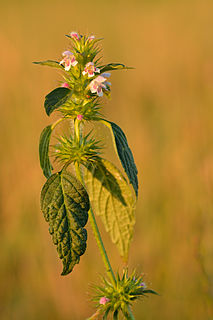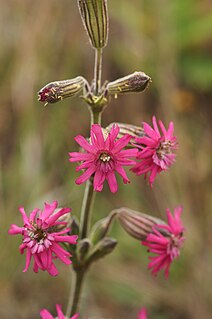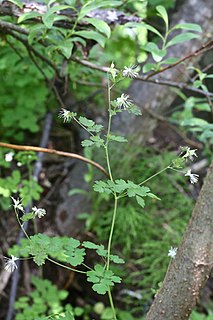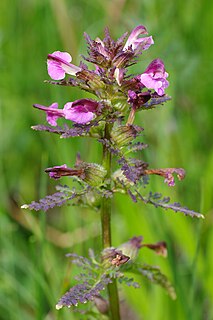
Elaeagnus angustifolia, commonly called Russian olive, silver berry, oleaster, or wild olive, is a species of Elaeagnus, native to western and central Asia, Iran, from southern Russia and Kazakhstan to Turkey, parts of Pakistan and parts of India. As of 2020, it is widely established in North America as an introduced species.

Thalictrum is a genus of 120-200 species of herbaceous perennial flowering plants in the buttercup family, Ranunculaceae, native mostly to temperate regions. Meadow-rue is a common name for plants in this genus.

Geum rivale, the water avens, is a flowering plant in the genus Geum within the family Rosaceae. Other names for the plant are nodding avens, drooping avens, cure-all, water flower and Indian chocolate. It is native to the temperate regions of Europe, Central Asia and parts of North America, where it is known as purple avens. It grows in bogs and damp meadows, and produces nodding red flowers from May to September.

Galeopsis tetrahit, the common hemp-nettle or brittlestem hempnettle, is a flowering plant in the family Lamiaceae, native to Europe and northwestern Asia.
Plant reproduction is the production of new offspring in plants, which can be accomplished by sexual or asexual reproduction. Sexual reproduction produces offspring by the fusion of gametes, resulting in offspring genetically different from either parent. Asexual reproduction produces new individuals without the fusion of gametes. The resulting clonal plants are genetically identical to the parent plant and each other, unless mutations occur.

Thalictrum dioicum, the early meadow-rue or quicksilver-weed, is a species of herbaceous plants in the family Ranunculaceae. Plants are typically upright growing woodland natives from Colorado Rocky Mountain forests to central and eastern North America including parts of south eastern Canada. This species has dioecious plants, with male and female flowers on separate plants blooming in early to mid spring.
This page provides a glossary of plant morphology. Botanists and other biologists who study plant morphology use a number of different terms to classify and identify plant organs and parts that can be observed using no more than a handheld magnifying lens. This page provides help in understanding the numerous other pages describing plants by their various taxa. The accompanying page—Plant morphology—provides an overview of the science of the external form of plants. There is also an alphabetical list: Glossary of botanical terms. In contrast, this page deals with botanical terms in a systematic manner, with some illustrations, and organized by plant anatomy and function in plant physiology.

Florissantia is an extinct genus of flowering plants in the Malvaceae subfamily Sterculioideae known from western North America and far eastern Asia. Flower, fruit, and pollen compression fossils have been found in formations ranging between the Early Eocene through to the Early Oligocene periods. The type species is Florissantia speirii and three additional species are known, Florissantia ashwillii, Florissantia quilchenensis, and Florissantia sikhote-alinensis.

Plagiobothrys nothofulvus is a species of flowering plant in the family Boraginaceae known by the common names rusty popcornflower and foothill snowdrops. It is native to western North America from Washington, and California, to northern Mexico. It is a spring wildflower in grassy meadows, woodlands, coastal sage scrub, and wetland-riparian habitats.

Thalictrum flavum, known by the common names common meadow-rue, poor man's rhubarb, and yellow meadow-rue, is a flowering plant species in the family Ranunculaceae. It is a native to Caucasus and Russia (Siberia). Growing to 100 cm (39 in) tall by 45 cm (18 in) broad, it is an herbaceous perennial producing clusters of fluffy yellow fragrant flowers in summer.

Thalassia testudinum, commonly known as turtlegrass, is a species of marine seagrass. It forms meadows in shallow sandy or muddy locations in the Caribbean Sea and the Gulf of Mexico. Turtle grass and other seagrasses form meadows which are important habitats and feeding grounds. The grass is eaten by turtles and herbivorous fish, supports many epiphytes, and provides habitat for juvenile fish and many invertebrate taxa.

Silene scouleri is a species of flowering plant in the family Caryophyllaceae known by the common names simple campion and Scouler's catchfly.

Thalictrum alpinum is a species of flowering plant in the buttercup family known by the common names alpine meadow-rue and arctic meadow-rue. It is native to Arctic and alpine regions of North America and Eurasia, including Alaska, northern Canada, and Greenland, and it occurs in cold, wet, boggy habitats in high mountains farther south.

Thalictrum fendleri is a species of flowering plant in the buttercup family known by the common name Fendler's meadow-rue. It is named in honor of Augustus Fendler.

Thalictrum sparsiflorum is a species of flowering plant in the buttercup family known by the common name fewflower meadow-rue. It is native to northwestern North America and parts of northeastern Asia. It grows in moist habitat, such as streambanks and forest understory. It is a perennial herb producing erect stems up to about a meter in maximum height. The leaves have compound blades divided into a few or many segments which are borne on long, slender petioles. The blades are usually finely hairy and glandular. The inflorescence is a leafy panicle of flowers. Unlike some other Thalictrum species which are dioecious, this species has bisexual flowers. Each has a calyx of five greenish sepals, and up to 20 light-colored dangling stamens tipped with large anthers. The flowers develop into compressed, beaked fruits.

Trifolium variegatum is a species of clover known by the common name whitetip clover. It is native to western North America from southern Alaska and British Columbia to Baja California, where it occurs in many types of habitat.

Coprosma rotundifolia is a native forest shrub of New Zealand found on the North, South, and Stewart Islands.

Cliffortia, or Caperose is a genus of plants that has been assigned to the rose family, with currently 132 known species. Its species can be found in southern Africa, particularly in the Cape Floristic Region where 124 of the species can be found, 109 of which are endemic to the CFR. Most species are ericoid shrubs, some small trees up to 5 m high, others more or less herbaceous groundcover. All are wind pollinated and have separate male and female flowers in the axils of the leaves, mostly individually, sometimes grouped, which may be on the same plant or on separate plants.

Thalictrum dasycarpum, known as tall meadow rue and purple meadow-rue, is a species of flowering plant in the buttercup family, Ranunculaceae. It is native to North America.

Pedicularis palustris, commonly known as marsh lousewort or red rattle, is a plant species in the family Orobanchaceae. It is native to central and northern Europe and Asia where it grows in wetlands and boggy habitats. The International Union for Conservation of Nature has assessed its conservation status as being of least concern.


















